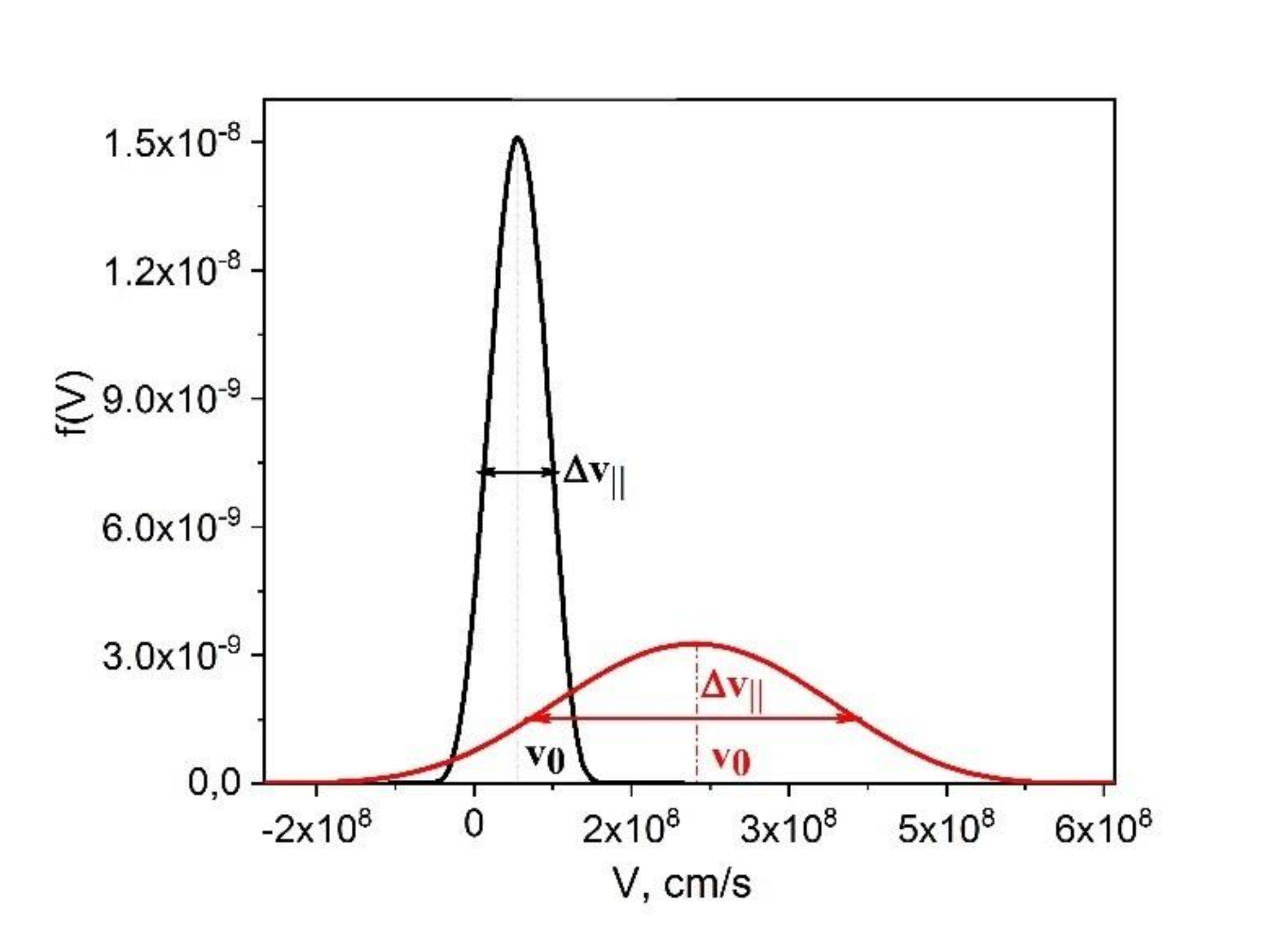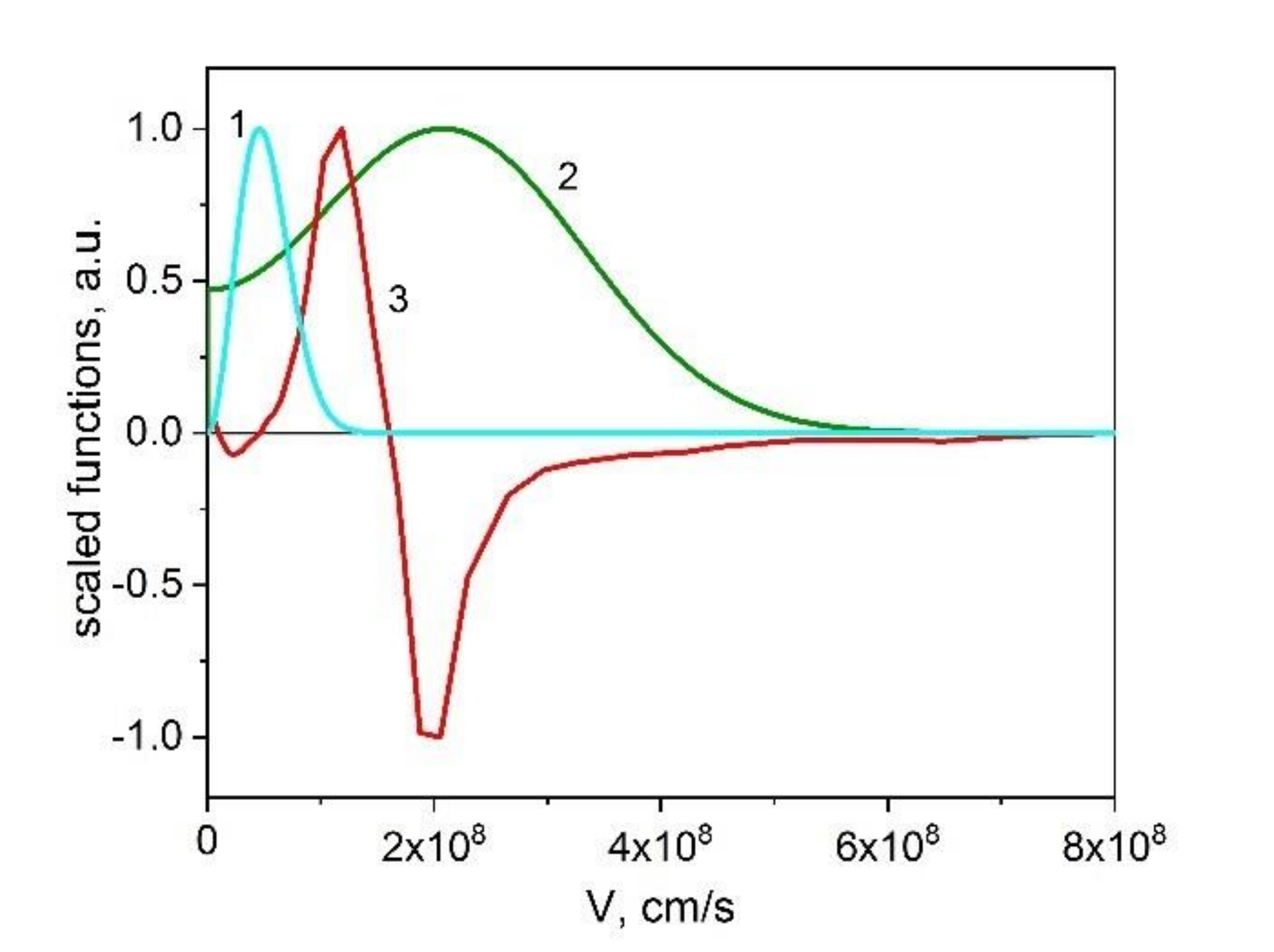Tunable THz Pulses Generation in Non-Equilibrium Magnetized Plasma: The Role of Plasma Kinetics
Abstract
1. Introduction
2. Models and Main Equations
2.1. THz Emission from Two-Color Plasma in the Presence of Static Magnetic Field: Elementary Model
2.2. THz Emission of Two-Color Plasma in the Presence of Static Magnetic Field: Kinetic Model of Plasma
3. Results and Discussion
3.1. Different Kinds of Electron Energy Distribution Functions Formed under the Action of Two-Color Laser Pulses
3.2. Spectral Characterictics of THz Pulses Emitted from Plasma in the Presence of Static Magnetic Field
4. Conclusions
Author Contributions
Funding
Conflicts of Interest
References
- Tonouchi, M. Cutting-Edge Terahertz Technology. Nat. Photonics 2007, 1, 97–105. [Google Scholar] [CrossRef]
- Nagai, N.; Sumitomo, M.; Imaizumi, M.; Fukasawa, R. Characterization of electron- or proton-irradiated Si space solar cells by THz spectroscopy. Semicond. Sci. Technol. 2006, 21, 201. [Google Scholar] [CrossRef]
- Liu, J.; Dai, J.; Chin, S.L.; Zhang, X.; Broadband, C. Terahertz wave remote sensing using coherent manipulation of fluorescence from asymmetrically ionized gases. Nat. Photonics 2010, 4, 627. [Google Scholar] [CrossRef]
- Fischer, B.M.; Walther, M.; Jepsen, P.U. Far-infrared vibrational modes of DNA components studied by terahertz time-domain spectroscopy. Phys. Med. Biol. 2002, 47, 3807. [Google Scholar] [CrossRef]
- Kampfrath, T.; Tanaka, K.; Nelson, K.A. Resonant and nonresonant control over matter and light by intense terahertz transients. Nat. Photonics 2013, 7, 680. [Google Scholar] [CrossRef]
- Kim, K.Y.; Glownia, J.H.; Taylor, A.; Rodriguez, J.G. Terahertz emission from ultrafast ionizing air in symmetry-broken laser fields. Opt. Express 2007, 15, 4577. [Google Scholar] [CrossRef]
- Gildenburg, V.B.; Vvedenskii, N.V. Optical-to-THz Wave Conversion via Excitation of Plasma Oscillations in the Tunneling-Ionization Process. Phys. Rev. Lett. 2007, 98, 245002. [Google Scholar] [CrossRef]
- Thomson, M.D.; Blank, V.; Roskos, H.G. Terahertz white-light pulses from an air plasma photo-induced by incommensurate two-color optical fields. Opt. Express 2010, 18, 23173. [Google Scholar] [CrossRef]
- Clerici, M.; Peccianti, M.; Schmidt, B.E.; Caspani, L.; Shalaby, M.; Giguère, M.; Lotti, A.; Couairon, A.; Légaré, F.; Ozaki, T.; et al. Wavelength scaling of terahertz generation by gas ionization. Phys. Rev. Lett. 2013, 110, 253901. [Google Scholar] [CrossRef]
- Oh, T.I.; Yoo, Y.J.; You, Y.S.; Kim, K.Y. Generation of strong terahertz fields exceeding 8 MV/cm at 1 kHz and real-time beam profiling. Appl. Phys. Lett. 2014, 105, 041103. [Google Scholar] [CrossRef]
- Kosareva, O.; Esaulkov, M.; Panov, N.; Andreeva, V.; Shipilo, D.; Solyankin, P.; Demircan, A.; Babushkin, I.; Makarov, V.; Morgner, U.; et al. Polarization control of terahertz radiation from two-color femtosecond gas breakdown plasma. Opt. Lett. 2018, 43, 90–93. [Google Scholar] [CrossRef] [PubMed]
- Bogatskaya, A.V.; Smetanin, I.V.; Volkova, E.A.; Popov, A.M. Guiding and amplification of microwave radiation in a plasma channel created in gas by intense ultraviolet laser pulse. Laser Part. Beams 2015, 33, 17–25. [Google Scholar] [CrossRef]
- Bogatskaya, A.V.; Popov, A.M. New approach to the problem of thz generation by intense two-color laser fields. Laser Phys. 2018, 28, 115301. [Google Scholar] [CrossRef]
- Bogatskaya, A.V.; Popov, A.M. Resonance-enhanced thz generation from aluminium vapour irradiated by ti–sa laser pulse and its second harmonic. Laser Phys. Lett. 2018, 15, 105301. [Google Scholar] [CrossRef]
- Shan, J.; Dadap, J.I.; Heinz, T.F. Circularly polarized light in the single-cycle limit: The nature of highly polychromatic radiation of defined polarization. Opt. Express 2009, 17, 7431–7439. [Google Scholar] [CrossRef] [PubMed]
- Katletz, S.; Pfleger, M.; Pühringer, H.; Mikulics, M.; Vieweg, N.; Peters, O.; Scherger, B.; Scheller, M.; Koch, M.; Wiesauer, K. Polarization sensitive terahertz imaging: Detection of birefringence and optical axis. Opt. Express 2012, 20, 23025–23035. [Google Scholar] [CrossRef]
- Zhang, P.; Su, F.; Zhang, S.; Mei, H.; Zhang, C.; Luo, X.; Dai, J.; Pi, L. Terahertz magnetic circular dichroism induced by exchange resonance in CoCr2O4 single crystal. Opt. Express 2015, 23, 17805–17814. [Google Scholar] [CrossRef]
- Wang, X.; Cui, Y.; Sun, W.; Ye, J.; Zhang, Y. Terahertz polarization real-time imaging based on balanced electro-optic detection. J. Opt. Soc. Am. A 2010, 27, 2387–2393. [Google Scholar] [CrossRef]
- Nagai, M.; Nakane, A.; Suzukawa, H.; Morimoto, T.; Ashida, M. Time-Domain Magnetic Field-Difference Spectroscopy for Semiconductors Using Circularly Polarized Terahertz Pulses. IEEE Trans. Terahertz Sci. Technol. 2020, 51–57. [Google Scholar] [CrossRef]
- Wen, H.; Lindenberg, A.M. Coherent Terahertz Polarization Control through Manipulation of Electron Trajectories. Phys. Rev. Lett. 2009, 103, 119903. [Google Scholar] [CrossRef]
- Jianming, D.; Karpowicz, N.; Zhang, X.-C. Coherent Polarization Control of Terahertz Waves Generated from Two-Color Laser-Induced Gas Plasma. Phys. Rev. Lett. 2009, 103, 023001. [Google Scholar] [CrossRef]
- Lu, X.; Zhang, X.-C. Generation of Elliptically Polarized Terahertz Waves from Laser-Induced Plasma with Double Helix Electrodes. Phys. Rev. Lett. 2012, 108, 123903. [Google Scholar] [CrossRef] [PubMed]
- Liu, C.S.; Tripathi, V.K. Tunable terahertz radiation from a tunnel ionized magnetized plasma cylinder. J. Appl. Phys. 2009, 105, 013313. [Google Scholar] [CrossRef]
- Wang, W.-M.; Gibbon, P.; Sheng, Z.-M.; Li, Y.-T. Tunable Circularly Polarized Terahertz Radiation from Magnetized Gas Plasma. Phys. Rev. Lett. 2014, 114, 253901. [Google Scholar] [CrossRef] [PubMed]
- Bogatskaya, A.V.; Gnezdovskaia, N.E.; Popov, A.M. The role of plasma kinetic processes during high intense thz pulses generation. In Proceedings of the 8th International Conference on Photonics, Optics and Laser Technology, Valletta, Malta, 27–29 February 2020. [Google Scholar]
- Delone, N.B.; Krainov, V.P. Tunneling and barrier-suppression ionization of atoms and ions in a laser radiation field. Phys. Usp. 1998, 41, 469. [Google Scholar] [CrossRef]
- Tong, X.M.; Lin, C.D. Empirical formula for static field ionization rates of atoms and molecules by lasers in the barrier-suppression regime. J. Phys. B 2005, 38, 2593. [Google Scholar] [CrossRef]
- Landau, L.D.; Lifshitz, E.M.; Pitaevskii, L.P. Electrodynamics of Continuous Media, 2nd ed.; Butterworth Heinemann: Oxford, UK, 1984. [Google Scholar]
- Ginzburg, V.L.; Gurevich, A.V. Nonlinear phenomena in a Plasma located in an alternating electromagnetic field. Sov. Phys. Usp. 1960, 3, 115–146. [Google Scholar] [CrossRef]
- Raizer, Y.P. Laser-Induced Discharge Phenomena; Consultants Bureau: New York, NY, USA, 1974. [Google Scholar]
- Hayashi, M. Determination of electron-xenon total excitation cross-sections, from threshold to 100 eV, from experimental values of Townsend’s α. J. Phys. D 1983, 16, 581. [Google Scholar] [CrossRef]
- Matsuda, Y.H.; Herlach, F.; Ikeda, S.; Miura, N. Generation of 600 T by electromagnetic flux compression with improved implosion symmetry. Rev. Sci. Instrum. 2002, 73, 4288–4294. [Google Scholar] [CrossRef]
- Portugall, O.; Puhlmann, N.; Muller, H.U.; Barczewski, M.; Stolpe, I.; von Ortenberg, M. Megagauss magnetic field generation in single-turn coils: New frontiers for scientific experiments. J. Phys. D Appl. Phys. 1999, 32, 2354–2366. [Google Scholar] [CrossRef]
- Hahn, S.; Kim, K.; Kim, K.; Hu, X.; Painter, T.; Dixon, I.; Kim, S.; Bhattarai, K.R.; Noguchi, S.; Jaroszynski, J.; et al. 45.5-tesla direct-current magnetic field generated with a high-temperature superconducting magnet. Nature 2019, 570, 496–499. [Google Scholar] [CrossRef] [PubMed]
- High Field Research Magnet. Available online: https://www.jastec-inc.com/e_top/ (accessed on 23 September 2020).



© 2020 by the authors. Licensee MDPI, Basel, Switzerland. This article is an open access article distributed under the terms and conditions of the Creative Commons Attribution (CC BY) license (http://creativecommons.org/licenses/by/4.0/).
Share and Cite
Bogatskaya, A.V.; Gnezdovskaia, N.E.; Popov, A.M. Tunable THz Pulses Generation in Non-Equilibrium Magnetized Plasma: The Role of Plasma Kinetics. Photonics 2020, 7, 82. https://doi.org/10.3390/photonics7040082
Bogatskaya AV, Gnezdovskaia NE, Popov AM. Tunable THz Pulses Generation in Non-Equilibrium Magnetized Plasma: The Role of Plasma Kinetics. Photonics. 2020; 7(4):82. https://doi.org/10.3390/photonics7040082
Chicago/Turabian StyleBogatskaya, Anna V., Nelli E. Gnezdovskaia, and Alexander M. Popov. 2020. "Tunable THz Pulses Generation in Non-Equilibrium Magnetized Plasma: The Role of Plasma Kinetics" Photonics 7, no. 4: 82. https://doi.org/10.3390/photonics7040082
APA StyleBogatskaya, A. V., Gnezdovskaia, N. E., & Popov, A. M. (2020). Tunable THz Pulses Generation in Non-Equilibrium Magnetized Plasma: The Role of Plasma Kinetics. Photonics, 7(4), 82. https://doi.org/10.3390/photonics7040082





